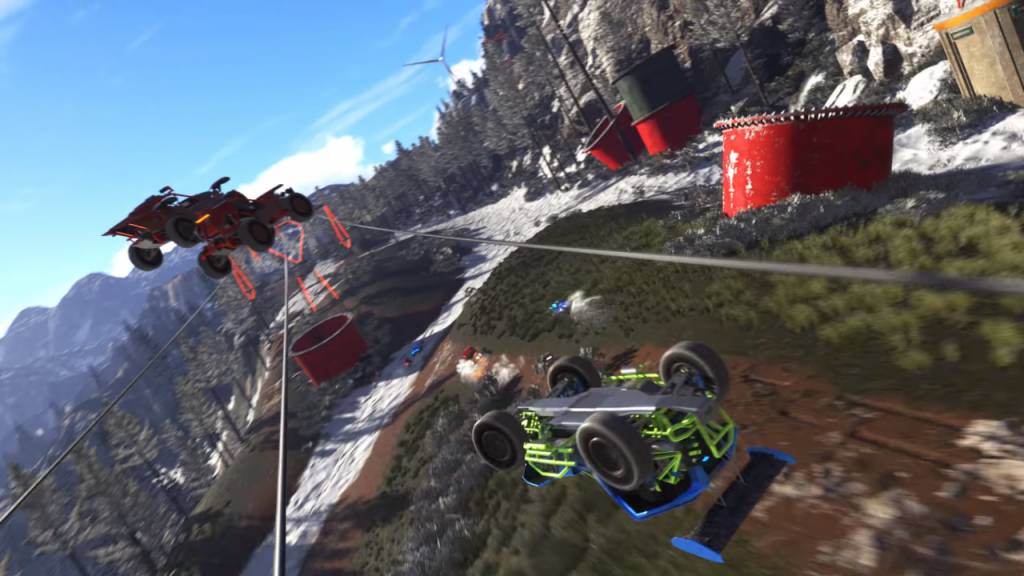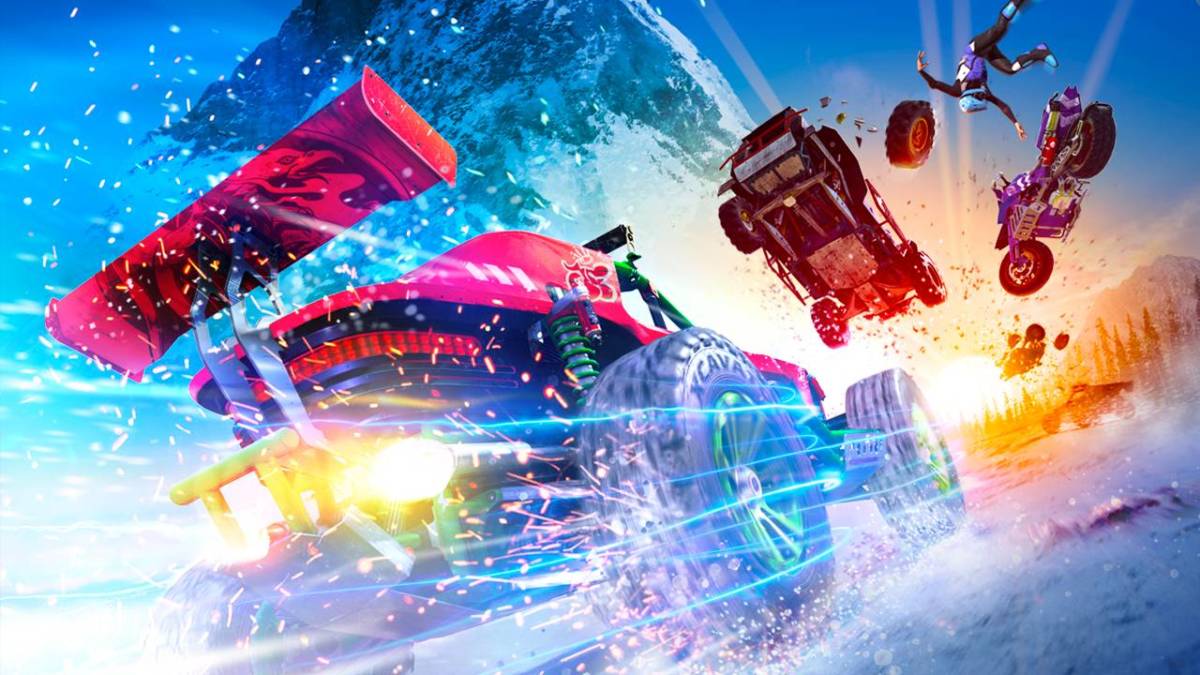Onrush is the product of two philosophies being smashed to together and seeing if it works. Redefining what it means to be a racing game, Onrush blends the classic arcade vehicular action you’d expect from the likes of Burnout, but with the competitive team based objectives you’d expect from the likes of Overwatch. You might think that sounds weird, and it is to begin with, but it ultimately becomes a fresh take on a genre as old as the industry itself.
nrDeveloped by the team responsible for the likes of Motorstorm and Drive Club, Onrush is a 6v6 team based racer. However, the goal isn’t to necessarily finish first. Instead, each race is centered around a key objective. The game will boast four modes when it launches in June, but we only got our grubby mitts on two.
Overdrive is based around building boost, then using it to earn points that contribute to a team total. Meanwhile, Countdown is like a team-based Outrun, as you compete to reach narrow checkpoints to add time to a shared countdown clock. The first team to run out of time loses. Each game mode goes for multiple rounds that follow on from each other, meaning you’re always behind the wheel.

Immediately, there’s an adjustment to be made between racing in other games and racing here. Instead of trying to wreck everyone on the track, you have possess a greater situational awareness. Also, greater restraint. It’s still tempting to force your teammates to collide with the environment at 100 miles per hour, but you mustn’t. You’re working as a team, after all.
Onrush, like most arcade racing games, focuses on boost. If you’re not boosting, you’re not winning, and if you’re not winning, you should just go home. You earn boost as you would expect: jumps, stunts and takedowns. Interestingly, you don’t earn boost for drifting like you would in other games, which can be annoying when you run out of boost on a corner. Still, with the amount of opportunities you’re provided to earn speedy juice, adding drifts to the mix would probably make your supplies infinite.
Using your boost fills your Rush gauge, which can be used to unleash your special ability. This is where the Overwatch ideas really come into play, as the game features 8 different classes that fit into 4 archetypes: bike, buggy, car and truck, each class of vehicle has their own abilities. Blade is like the dirt bike version of Tron’s lightcycle, whilst the Enforcer bullies opponents and leave behind a trail that blinds the other team.

Different classes have different strengths and weaknesses, from basic things like the trucks can take a big hit whilst bikes are practically asking to be victimised, to more complex things like how they earn Rush meter. Depending on the vehicle you use, you can earn bonus Rush by performing barrel rolls or doing tricks on your bike. It’s all about finding the class that’s right for you.
Handling is, again, pretty much what you’d expect from an arcade racer. Your car likes to slide and looks good doing it, meaning you can hit some sweet drifts on the corners. Though each car handles differently, each of them feels great to drive. The only real problem with the core racing is that it’s sometimes too easy to wreck. There were moments were all it took was a slight knock on a barrier for the screen to flash with the word “WRECKED”.

Still, even if you do wreck, you’re back in the thick of it within seconds thanks to the Stampede system, which makes sure all competitors are kept close together. Carnage is a constant, as the track is always filled with cars just waiting to be obliterated. On top of the 12 racers, each race is populated with several “fodder” vehicles that race alongside the pack, and their sole existence is to be obliterated by you and the other 11 players. Doing so provides even more boost, so they’re worth nailing if there are no jumps nearby.
There’s a single player campaign, which can also be completed with up to 5 friends in co-op, but the game comes alive when you’re racing against actual humans and not AI. The AI can feel a little braindead, not going for objectives or knocking you away from a checkpoint despite being on your team.
Like any other team based competitive game, communication and teamwork is key, along with some strategic use of your Rush ability. If you know that a round is going to end up being won by the other team, it’s better to save your Rush for the next round. You should also save your Rush for when it’ll be handy. No point deploying the Blade’s Trailblazer Rush when you’re at the back of the pack, as it won’t hit anyone.
Once you get into the swing of things, the multiplayer is fantastic. Every jump is a chance to crush someone underneath your chassis. Every fool who decides to ride a bike is an open invitation to annihilate the poor sucker at high speed. Every turn is another opportunity to destroy someone’s tailpipe. No, not like that. Get your mind out of the gutter. Point is, the battles you have will be just as memorable as the cars or tracks you race.
Our only real concern at the moment is one of longevity. Onrush is a spectacle to behold, but even something truly spectacular can get old after a while, and it’s possible Onrush can suffer a similar fate. Codemasters have stated that they’re planning on supporting the game beyond launch with free updates and whatnot, which should include new classes, new tracks and new modes that’ll keep the game fresh, so we’ll have to wait and see.
Either way, we’re optimistic about Onrush’s chances. The fusion of styles is a shot in the arm for the racing genre, and one that has every chance of catching on with gamers all over. We certainly felt the Rush, and you probably will too when the game launches this June for PS4 and Xbox One.
Some of the coverage you find on Cultured Vultures contains affiliate links, which provide us with small commissions based on purchases made from visiting our site. We cover gaming news, movie reviews, wrestling and much more.



